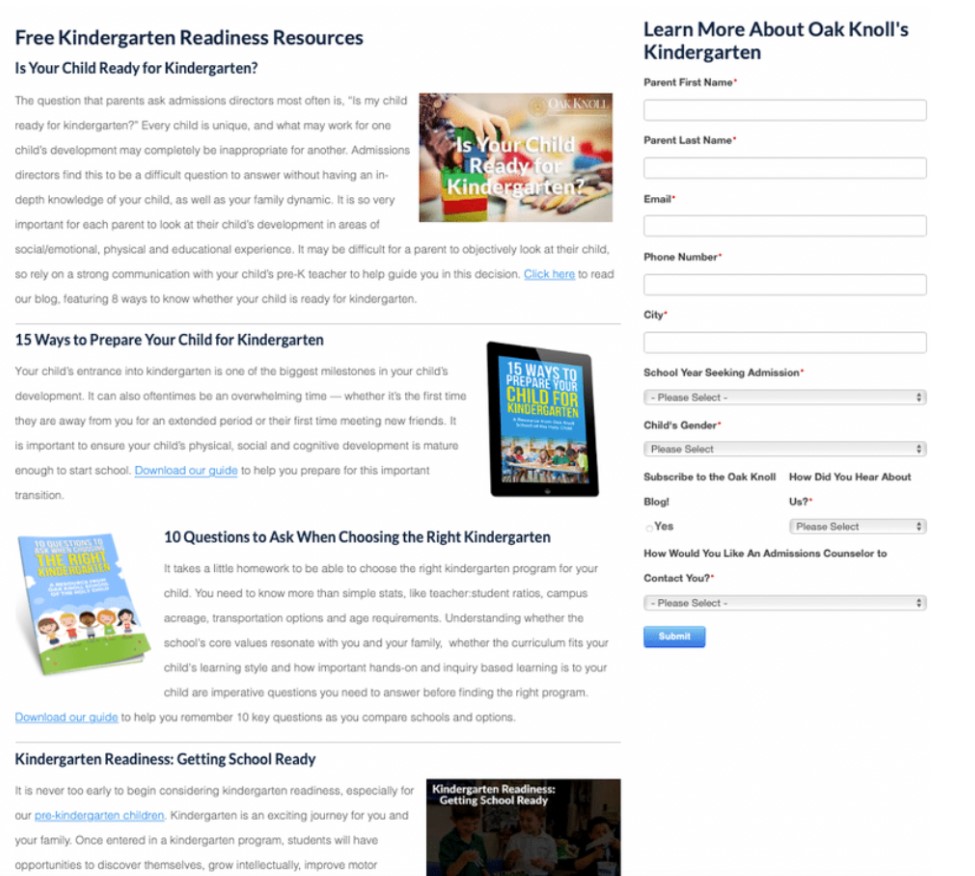By Trevor Waddington, Principal, Truth Tree
What is Content Marketing for Schools?
When Google talks, you need to listen. Content is king and queen when it comes to optimizing your online presence. Use this step-by-step guide to learn the basics of content marketing for schools, tips for optimizing it, and how to position your content to maximize your efforts.
What Is Content Marketing?
Your school’s website is the most important gateway to your school, and often the first place where prospective parents find information about your program. Your website is your marketing workhorse.
What happens if your school’s website isn’t easily found? Talk about missed opportunities to share your school with more prospects. It also likely means a drop in enrollment. Yikes.
Good web design, a positive user experience, and page optimization are all key to ensuring your school’s website can be found. When compared to other types of marketing efforts, content marketing for schools comes with a very diverse payload of benefits that you can take advantage of.
Content marketing is a form of promotion that uses content–articles, blog posts, videos, how-tos, and other resources–as a way to increase awareness about your school. Prospective parents (and students) are searching the web for information and you’re providing it! In return, your school benefits from increased web traffic, a more valuable website, and an engaged audience that values the information you’re providing.
- Plus, content marketing can also boost your search rankings so that your school is better positioned to be discovered when parents search for schools.
- And bonus! Your content marketing for schools helps position your school as an educational thought leader. Content marketing for schools carries a wide range of benefits!
How Can Content Marketing for Schools Benefit Your School?
Let’s take a closer look at how content marketing benefits schools and some steps to get you started:
Build Authority and Credibility with Humans
Sharing your school’s expertise is one of the most important reasons to utilize strategy of content marketing for schools. Prospects and current parents want to know where your school shines, and producing content that illustrates your expertise is the best way to put a stake in the ground and get the word out. The savvy content marketer shares their school’s expertise but in a way that helps answer parents’ burning questions and needs. A great blog gives you a venue to show off your credibility.
Build Authority and Credibility with Google
In addition to building credibility with parents, schools also need to be seen by search engines as website authorities. One of the keys to good SEO for schools is ensuring that your school’s website is seen as informative, authoritative, and helpful. Search engines like to point their users to the best and most highly regarded websites and a content marketing strategy can be used to boost your search rankings as part of your SEO strategy. The more useful, helpful content you produce as part of your strategy in content marketing for schools, the better returns you’ll receive for your effort.

Website authority is a measurement of how seriously your site is being taken. The more content you have online, the greater the chances are that other sources will link to your content and it will show up in Google’s search results. Content marketing for schools serves to both increase your digital footprint and relevancy, ensuring that your website gains authority from organic traffic.
Backlinks are a major factor in search engine rankings. As the number of incoming links to your content increases, you should see an improvement in your search engine rankings. And the more relevant content that you have on your site, the more backlinks you’ll have. Google will notice that high-authority websites have linked to yours and will send a message to Google that your school is a trustworthy source for the topic. You get Google’s “Stamp of Approval,” which raises your school’s rank for those keywords and increases your chances of being found by users asking the questions you’ve so expertly answered. All of these benefits arise from content marketing for schools, so it’s strongly recommended to develop a strategy for it sooner than later.
Step 1: Identify Objectives of Your Content Marketing for Schools Plan
Now that you have a basic understanding of the benefits of content marketing for schools, it’s time to start thinking about how to develop a strategy for your school! The most important part of this process is to start with an understanding of your overall marketing objectives, where your school shines, and what expertise you want to share with the world. For example, do you have a marketing objective to build awareness and name recognition for your school? Or do you want to correct misconceptions? Or perhaps you want to recruit more students to your Kindergarten program? Think deeply about where you want to focus your efforts and the content will follow. Once your focus is set on an objective, content marketing for schools will generally become easier as you come to understand what message you need to send to the public.
Discover Content Marketing Services
Step 2: Identify Your School’s Area of Expertise and Parents’ Needs
Once you know where you want to focus, it’s time to delve deeper into how to approach content development, another crucial step in content marketing for schools.
Think about:
- What do your current parents love about your school?
- What are prospects excited to know more about? What are their most frequently asked questions?
- When asked on a tour, what do your teachers rave about?
- In what areas does your school legitimately have expertise? A special program, special staffing, certifications, unique facilities, etc.
- What are the most common parenting issues you’re seeing? Can you offer resources to help?
Content marketing for schools should be helpful, informative, and personable, identifying these issues and explaining them creates an impression of authority.
Step 3: Identify What Kinds of Content Are Right for Your School’s Content Marketing Strategy
It’s easy to think of content marketing as this monolithic marketing idea. Yet what does it look like on the ground level? The truth is, content marketing is a very diverse field and there are multiple avenues that you can go down.
Strategic content that actually solves a problem is what will drive lead-generating results. Let’s take a closer look at some of the different types of content marketing that you could use:
Blog Posts
The most common kind of content marketing for schools is blog posts, and there’s a reason for that. A great blog post is one of the best ways to tell a story or build up your credibility.
You need to ensure that you post new articles regularly so that people keep coming back to read your blog. You should also make sure that you post links to the content on social media. Not only will this give the content a wider audience, but each post also counts as a backlink and boosts your profile.
Another tactic is to write guest blogs to gain backlinks from reputable sites and steer more organic traffic to your website. This will support your SEO efforts and will also put your school in front of a new audience. Plus, by subtly linking back to your own page, you open your school up to draw traffic from the host’s audience. Since this audience is obviously interested in the topics you can help with, you’ll start the process of becoming an authority on the subject and possibly future subjects.
Pro Tip: Use relevant keywords and phrases in your content that prospective parents might search for. For example, if your high school is called an Upper School be sure that your website and ads are using words that parents use (they don’t search for “upper school near me”). Or, if you have a strong science department, consider developing a blog that offers great activities to build your child’s scientific curiosity. In this content, you can include strategic keywords that help your content be found. When creating content marketing for parents, you have to make content based on what they’re searching for to ensure that you come up when they make their search.
Videos
While video marketing is its own distinct discipline, videos also count as content. Whether you host them on your own site or another site and embed them, videos are a compelling way to tell stories and talk about your successes, and as a part of a strategy of content marketing for schools, a well-made video can be the highlight of the entire campaign, shining a light on what makes your school special.
Infographics, White Papers, eBooks
If you want to become well-known as an authoritative source, you need to start posting authoritative content. Infographics are a particularly good kind of content, as they can condense complex information down into an easily digested format.
While infographics are a great way to discuss data, they aren’t always the best way. Sometimes, you’ll need to post content that is something a little more in-depth, which is where white papers come in.
Posting this kind of content is a great way to build up your backlinks but is also more research-intensive, so consider peppering it into the rest of your content.
Pillar Pages
Develop enough content surrounding one or more related topics that allow Google to identify your site as an authority. Google favors topic clusters or groups of related content that cover a broad subject area. The more content you have surrounding this general topic, the more authority (better ranking) is given. What can your school be an expert in? For Oak Knoll, we shine in helping students (and parents) get ready for Kindergarten. By identifying this particular segment of the market, we were able to generate a content marketing strategy for their school, further honing their specialization and displaying it for prospective parents. Consider what specialization your school will put forth in their content marketing, and the content you create will be far more honed and attention-grabbing.

Step 4: Produce Content
Use your community for inspiration and/or content producers. Think about:
- Teachers
- Staff
- Parents
- Alumni
- Grandfriends
- Tutors
- Summer camp staff
- Admissions team
Explore incentives and ways to make production easy:
- Stipends (10 blogs for 100 bucks!)
- Q&A interviews (sit down for a quick interview or send a list of questions to answer via email)
- Mandatory admin team think pieces (get your Head of School on board for your leadership team to commit to two high-level expertise blogs a year)
- Crowdsourcing content (poll your parents, faculty, or other groups to easily capture great content)
- Build relationships/trust with your community leaders (Lay the foundation for true partnership. It will pay dividends when it’s time to ask for content!)
Step 5: Share Your Content Online
One thing that helps you build an online presence is being shared. When people share the content you post, it’s effectively free marketing. You get more eyes on your content without any extra expense. The general recommendation is to spend about 20% of your content marketing work developing the actual content and 80% of your time distributing it, sharing it, and ensuring that it gets out into the world.
If your content is shared through social media posts or if it goes viral, you’ll gain a lot of interest and followers, which can then be converted into students and happy parents. Properly implemented content marketing for schools can have untold returns when the message resonates with your target market. Once you’re able to establish this base of parents and stakeholders who are interested in your content, the rest of your content marketing for schools will receive the benefit of more impressions from all the friends and followers that these parents have.
The 80/20 Rule
Pro Tip #1: In addition to creating content, develop a “go-to” list of websites, influencers, and organizations, with whom you can share the content and who can also pass it along. Think about off-campus and school-specific communication outlets to share out. Content marketing for schools isn’t just about what you’re sharing, it’s also largely dependent on who you’re sharing it with.
Off-Campus:
- Feeder schools
- Psychologists and parenting groups
- Local parenting websites (tampabaymoms.com, etc.)
- Neighborhood listservs
- Pediatricians
- Playgroups
- MeetUp Groups
- NAIS, other educational groups
- DEIJ groups
School Spaces:
- Admissions inquiries, applicants, etc.
- Website homepage, etc.
- School newsletter
- Social media
- Staff and board communication
- PTA
- Summer camp lists
- After school program lists
Pro Tip #2: Content marketing for schools is a great way to remarket to your current families too. Remind them why they chose your school in the first place and create content that they want to share. Get them working for you!
Follow this playbook guide to content marketing for schools and you’ll be set! Rally your troops, think about where your school can show some expertise, start cranking out (and sharing!) your content and watch it improve your online visibility!
Need to Level Up Your Content Marketing?
Need help with your content marketing through Google Ads, Social Ads, Search Engine Optimization (SEO), or Email Marketing? Truth Tree’s expert team is here to help!











